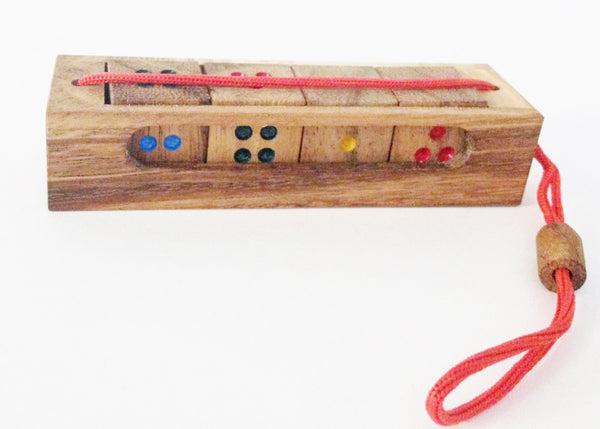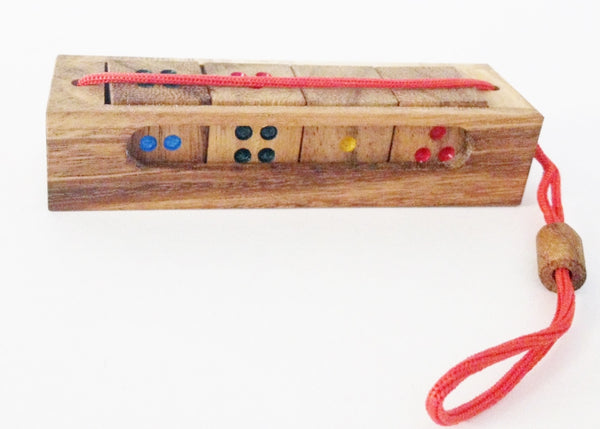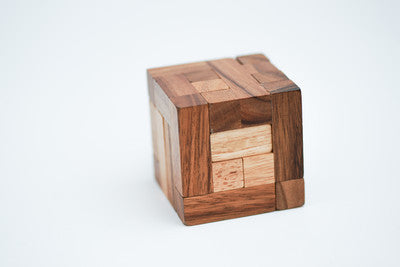10 Sum - Wooden Puzzle
Sold Out
The game includes a rectangle wooden box and 4 wooden dices. Arrange the cubes so you see the sum reaches 10 on all four sides. Let's explore!
Cube in a Box - Wooden Puzzle
$26.99
Cube in a Box!
Try to put all the 9 different pieces back into a cube!
The cube can be assembled into a checkered pattern but it is not required to solve the puzzle.
Five Different - Wooden Brain Teaser
$16.99
Five Different
Koncy Wooden Puzzle - Brain Teaser
$28.99
This dynamic cube is one of our hardest, and also happens to be one of our favorites. The Koncy Puzzle contains six pieces. Nothing connects these pieces to each other, or lets the cube retain its form, besides the unique and unconventional shapes of the pieces themselves. Dismantling this cube is a very complex and gentle affair. It should be done one step at a time, and is difficult in and of itself.
The 6 pieces slide apart and return to a cube. It is important to note the last piece to come apart as it is the last to be inserted as the cube is reassembled.
Othello (Reversi) - Wooden Game
$22.69
Named after the Shakespeare play due to its traditional black and white pieces Othello was invented in England in the late 1800's. Designed as a simplified version of Go, Othello (or Reversi) offers a fun challenge for all ages.
Initially the board is empty except for 4 pegs - 2 of each color- placed in the central square on opposing corners. On each turn a player places a peg of their color onto the board in such a way as to capture one or more of the opponent's pegs, if you can't capture a peg you must skip your turn. Pegs are captured when a peg placed on the board sandwiches one or more of your opponents pegs between two pegs of your own color. Pegs can be captured horizontally, vertically and diagonally.
The game is over when the board is full or neither player can move, the player with the most pegs of their color wins.
The board allows you to play another Game: Solitaire.
At the beginning of the game the peg in the center of the board is removed. Moves are made by jumping a peg over an adjacent peg, removing each peg as you pass over it. The aim of the game is to remove all the pegs until only one peg is left in the center of the board.
Step On Me (Challenging Connect 4) - Wooden Game
$54.00
Content:
° Main board with 16 holes
° Two stands for the game pieces with 12 holes each
° 24 Wooden cylinders (the game pieces), varied in color and size.
Each player starts the game with 4 long wooden cylinders and 8 short cylinders (half the length of the long cylinders)
Objective:
To create a row of four cylinders of the same color, visible on the surface of the board, in either a straight or diagonal line.
Preparations:
l. Remove the two stands from the main board, and reattach them to the sides of the main board horizontally.
2. Remove the cylinders from the main board and divide them between the two players according to color. The cylinders must then be arranged on the two stands. The four long cylinders must be placed in the front row (the closest to the main board) and the short cylinders in the rest of the stand.
3. The two players then sit in front of one another with the board between them. Make sure that each player can only view her/his own cylinders, while not viewing the opponent's cylinders. Also, during the game, the opponents must not view the main board from above (thus revealing the arrangements of the short cylinders on the board).
4. Prior to commencing the game, each player must place on the main board one of the small cylinders, without the opponent knowing where the piece is (each opponent looks away while the player places one small cylinder, so the location of it won't be revealed)
5. The starting player will be chosen by a draw.
Process of the game:
Each player, in her/his turn, must place one cylinder on the main board.
° lf the cylinder is long, it will be visible on the surface of the main board.
° lf the cylinder is short, it will "disappear" inside the main board. Try to remember where the small cylinders are placed as the game progresses.
° When a small cylinder is placed in a hole which already contains another small cylinder, the second cylinder will be visible on the surface of the main board.
° lf a long cylinder is being placed in a hole which already contains a small cylinder, the long cylinder will stick out from the main board. lf this happens, the long cylinder is immediately disqualified and that opponent forfeits the game.
° Please remember that the main board is being "booby-trapped" at the beginning of the game, and the use of long cylinders is thus not safe.
The first player to create a row of four cylinders visible on the surface of the board, in either a straight
or diagonal line, wins the game.








